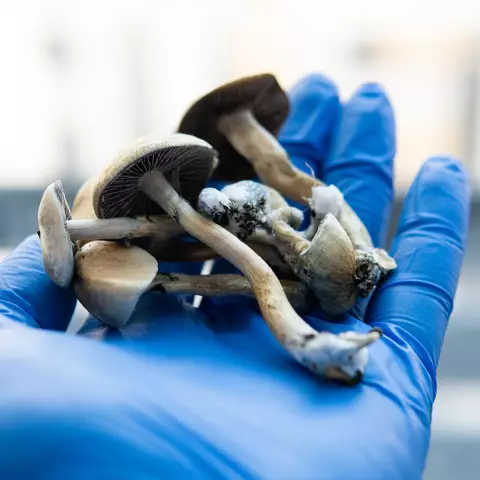- Author Rachel Wainwright [email protected].
- Public 2023-12-15 07:39.
- Last modified 2025-11-02 20:14.
White mushrooms
The porcini mushroom belongs to the boletus family, in taste and nutritional value it surpasses most of the mushrooms we know.
The ratio of BJU in the product

Source: depositphotos.com How to burn 34 kcal?
| Walking | 9 minutes |
| Jogging | 4 minutes |
| Swimming | 3 min. |
| A bike | 5 minutes. |
| Aerobics | 7 minutes |
| Household chores | 11 minutes |
Useful properties of porcini mushrooms
Porcini mushrooms have a thick knife, their surface can be brown, white, sometimes pink - it depends on the area in which the mushrooms grow. A distinctive feature of the fungus is the tubular layer under the cap, which is white in young mushrooms, and yellow or greenish in old ones.
Mushrooms contain vitamins C, B, E, zinc, potassium, phosphorus, fluorine, cobalt, calcium, sodium, manganese, magnesium, sulfur, a large amount of polysaccharides, ether lecithin, carbohydrates, proteins. The calorie content of fresh porcini mushrooms is 34 kcal per 100 g. The calorie content of porcini mushrooms fried in vegetable oil is 162 kcal.
Known for wound healing, tonic and antitumor properties of porcini mushrooms. They are recommended for use with anemia, atherosclerosis, because mushrooms prevent the deposition of cholesterol on the vascular walls.
Porcini mushrooms are useful for diseases of the liver, eyes, kidneys, bone marrow, they are a good immunostimulant, inhibit the growth of fungi, viruses, and pathogenic bacteria.
Such a healing property of porcini mushrooms as stimulation of the secretion of gastric juice has been established, and it is noted that in this quality they significantly exceed meat broths.
The use of porcini mushrooms
Porcini mushrooms are used fried, pickled, salted, boiled, dried, but you need to take into account that when cooked at a temperature of 100 degrees and when frozen, they lose their healing properties.
In addition, the chitin contained in them significantly slows down the absorption of freshly prepared mushrooms, and therefore, for therapeutic purposes, they are recommended to be eaten exclusively in salted or dried form.
To prevent cancer, powdered dry porcini mushrooms take one teaspoon daily. It is also useful to add dried mushroom powder to the first and second courses.
Despite the low calorie content, porcini mushrooms are not considered a dietary product, they are difficult to digest, especially when fried, and are digested even more slowly than meat.

Contraindications
Like any other mushrooms, porcini are powerful sorbents that absorb toxins and radioactive substances, for example, lead, cadmium, cesium, strontium. Therefore, mushroom picking in industrial areas and near motorways is prohibited.
Porcini mushrooms are contraindicated for children under 12-14 liters: their digestive system does not yet produce enzymes that can process the chitin contained in the mushrooms.
It is important to be careful when picking mushrooms. A great danger is a false white mushroom, which is also called a gall or bitter mushroom, bitter mushroom. Despite the external similarity, the false mushroom belongs to a different family and has a bitter taste, which is enhanced by heat treatment. The false porcini mushroom has the same leg expanding to the bottom, the same tubular layer under the cap, but a dirty white or pink color that is uncharacteristic for a porcini mushroom. The main difference between the false porcini mushroom is that the flesh on the cut turns pink, while the real mushroom does not. More importantly, there is a net on the stem of the false ceps, which makes it look like a boletus and is often misleading.
Another double of the porcini mushroom is the satanic mushroom, which is very poisonous and can cause severe poisoning. The satanic mushroom is distinguished by the rough surface of the cap, often of a grayish color. Its stem is bright yellowish-red, red; the tubular layer of this mushroom can be yellowish, red-brown or red-olive. It should also be borne in mind that the pulp of the poisonous double on the cut quickly turns pink or blue. Plus, old satanic mushrooms have an unpleasant odor.
YouTube video related to the article:
Found a mistake in the text? Select it and press Ctrl + Enter.






